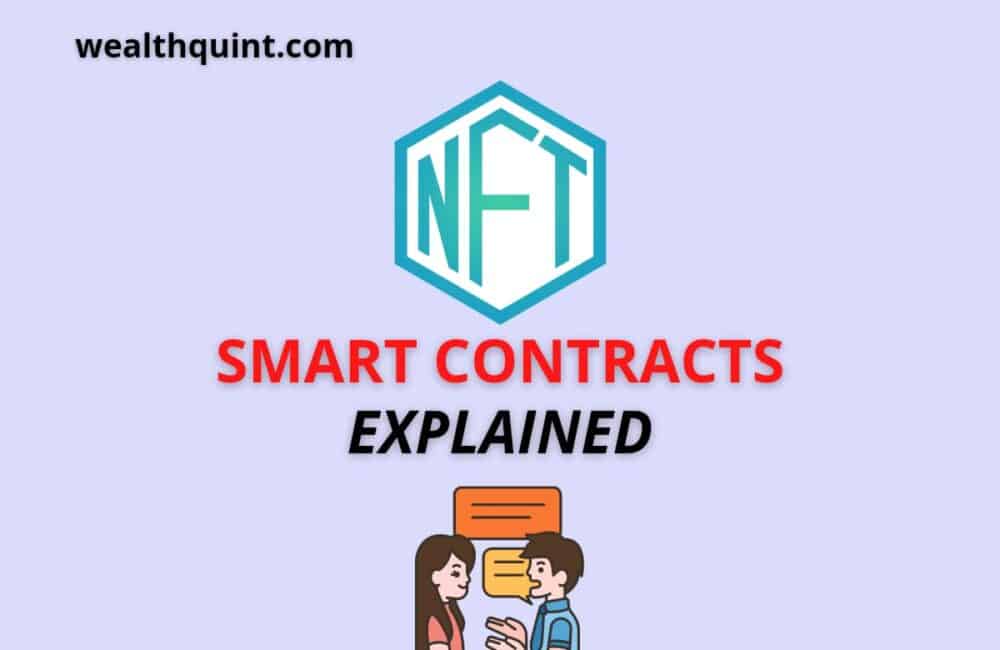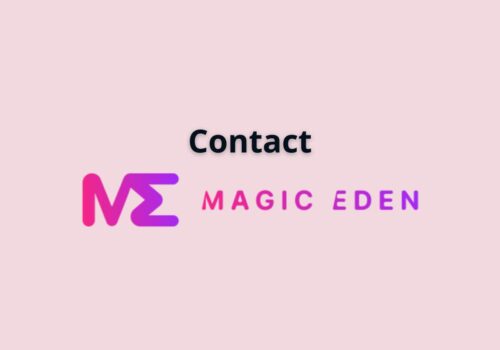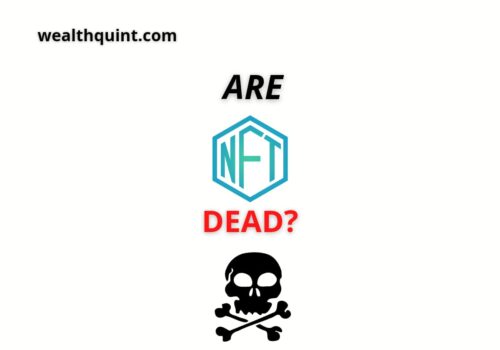NFTs, or new forms of intellectual property, are very popular right now. NFTs are blockchain-based cryptocurrencies. Smart contracts underpin the functionality of an NFT.
What Is NFT Smart Contract?
A smart contract is a piece of blockchain-based code. This allows the program to hold the data from an NEFT transaction.
When you’re set, you’ll be able to view this information whenever you choose. The smart contract also guarantees that the data stored is both accessible and unchangeable.
The operation of non-fungible coins relies heavily on smart contracts. They are basically sections of software code that let the network hold data in an unchangeable and transparent way.
These codes are ultimately in charge of the NFTs, which are digital assets. Permanent identification information is accessible with smart contracts.
They also prevent NFTs from being dismantled and distributed in tiny pieces.
The digital assets will be one-of-a-kind and non-replicable, due to the smart contract. NFTs have significance because they are limited and uncommon. On the blockchain, just about everything may be digitally encoded.
A set of if or when lines are entered as codes into the blockchain and form the foundation of smart contracts.
These are controlled by a group of computers that carry out the smart contract’s agreement operations. Unless the stated requirements are attained and validated are the actions carried out.
Also Read: Top NFT Analytics Tools
How Does The NFT Smart Contract Work?
Smart Contracts can be included in an NFT to allow users to obtain and call assets. A consumer can, for example, utilize a smart contract to listen to a song contained in an NFT.
Both participants would accept the conditions in a smart contract, and afterward, compensate the agreed-upon amount and gain entry to the purchased song.
Once consumers click play on their apps, this procedure is most likely to operate in the background. A smart contract could claim control of an NFT and distribute it.
Depending on the smart contract’s occurrences and restrictions, a consumer can transfer it to another contract or user.
Users will be able to declassify a wide range of use cases and unique combinations of smart contracts and NFTs.
Smart contracts may create complex contractual arrangements and arrangements, whereas the blockchain’s underpinning mechanics can help to determine them.
NFTs are made up of software code that is packaged in smart contracts and is intended to deliver significant benefits to the NFT producers.
The code can specify the restrictions on a purchaser’s usage NFT, as well as receive automated royalty fees from resale transactions and provide evidence of possession.
When the smart contract’s code is completed, it is eternally created as a coin on a blockchain such as Ethereum.
What Are The Standards Of Smart Contract For Creating NFT?
Because Ethereum has been the most widely utilized NFT. We’ll take a glance at the Ethereum specifications. ERC 1155 and ERC 721 are Ethereum’s specifications
1. ERC 721 Standard
The ERC 721 Standard is an international standard that explains well how to create non-fungible tokens (NFTs) on the Ethereum network.
ERC 721 is different from any other token. A smart contract’s functions are defined by the ERC721 standard. When transferring a token, you’ll need two kinds of data:
- Token’s Smart Contract Identification Address
- A single ERC721 can handle numerous tokens.
2. ERC 1155 Standard
The ERC 1155 standard is a multi-token standard that enables each token id to indicate its customizable token category along with its metadata characteristics and supply.
TRON, EOS, TEZOS, and Solarium, in addition to Ethereum, are smart contract blockchains containing NFT features.
These NFT standards will aid in the tokens’ compatibility. The functions of the NFT tokens will vary based on the blockchain systems where NFTs tokens are used.
A blockchain’s set of features may cause NFT activities to vary. However, these differences are typically minor, and smart contracts are adjusted to fit the blockchain ecosystems in which they are run.
What Do Smart Contracts Cover?
The real rights which are being transferred are covered by smart contracts, among other things.
If you hold an asset, it’s presumed that you hold the copyright to that too. But the reality is different. The terms “ownership” and “copyright rights” are not interchangeable.
The copyright does not belong to the individual who purchases a digital asset. In most circumstances, except otherwise stated in the contract, the creator retains the copyright.
The purchaser’s rights are specified in the NFT license. The NFT license distinguishes the NFT from the art form.
A photo or a piece of music or sound could be used as art. The license spells forth the rights that are being given up.
In most situations, the license would grant the purchaser access to show the artwork as well as a commercial license allowing them to produce items including the artwork.
However, these terms may vary from transaction to transaction and will need to be specifically put into the smart contract.
What Do Smart Contracts Use To Ensure Authenticity?
A smart contract’s major goal is to validate its legitimacy. The asset and its ownership can be verified via smart contracts.
They may use open blockchains to track the token’s distinctive origins, including how it was formed and tied to productive activity.
The open blockchains can be used to validate the wallet id and related metadata.
However, it is unable to connect to any real-life person. Furthermore, it is unable to determine whether the inventor has the authority to tie the NFT to certain works.
The identities of the makers will be verified by the sites that show and sell NFTs. This is often performed manually in many circumstances.
How Do Smart Contracts Prevent Counterfeiting?
When you purchase an NFT, you will receive a one-of-a-kind token containing the smart contract’s necessary details.
The transaction is recorded on the blockchain. This data, which contains the transaction records and evidence of ownership, is now open on the blockchain.
The asset can be shown and sold by the owner. If the picture is recreated, the blockchain will confirm ownership, rendering the recreated images or assets is useless.
On the blockchain, only the owner’s private key is utilized to allow the exchange of any NFT.
Beyond transactions, NFTs can be used for other things. They could also be implemented to handle financial transactions as well as the supply chain for items.
Also Read: Top NFT Trading Strategies
Uses Of Smart Contracts
Smart Contracts are useful because of the following features:
- A smart contract’s advantage is that it can be used in commercial transactions where a particular agreement needs to be followed.
- They increase efficiency and accuracy by removing the need for documentation.
- They foster trust since no one can alter the terms after they have been established.
- They’re quite safe and difficult to break into.
- As middlemen are removed, there are several savings.
Moreover, Smart contracts, in general, are the foundation of any NFT. Smart contracts have a lot of possibilities for future transactions like housing loans as well as other business-related operations.
Consider how a smart contract can eliminate the absence of trust that can arise when dealing with others.
NFT Smart Contract Example
1. Gaming
A set of smart contracts and NFT groupings could be used to regulate tournaments in games.
NFTs may contain all of a player’s in-game goods, including skins, assets, and tools.
Players could adopt several rules for how the assets of contestants in a tournament should be distributed to the victor of every round via a set of smart contracts.
2. Streaming
An NFT can contain multiple movies or episodes of a show.
Consumers can follow the series via a smart contract, which accepts a micropayment but then plays the movie or series on the user’s phone for a set amount of time or clicks.
3. Exhibits Of Art
An artist can incorporate their work in an NFT and use it to establish a smart contract that defines the terms of its use.
Fine art galleries can then acquire this art and display it on a real screen in their space, dividing the money from tickets sold with the artist according to the agreed terms upon utilizing the smart contract.
Is An NFT A Type Of Smart Contract?
Yes, NFT is a type of Smart Contract. Smart contracts, that manage transferability and ownership verification, are at the heart of NFTs.
The ERC-721 protocol is used. It is an NFT specification for smart contracts which gives functionality.
How To Create NFT Smart Contracts?
Minting is the process of creating an NFT. You’re essentially creating the smart contract code itself.
The NFT’s attributes are determined by the smart contract code, which then contributes them to the appropriate blockchain where the NFT is coded.
For smart contracts, several standards have been defined. Ethereum was one of the first cryptocurrencies to implement standards.
Following are the steps of creating an NFT Smart Contract:
Step 1: Prepare For The Project
To get started, we’ll use the hardhat, which will give us a baseline for deploying the contract, performing tests, and so on.
Step 2: Installing The Hardhat
We’ll use yarn to install hardhat as a development dependency. You’ll also need to perform some commands over here.
Step 3: Making The Necessary Files And Directories
Let’s begin by making a contract directory in the root folder. We can construct our first contract file inside the folder after we’ve created it.
Step 4: Developing The Smart Contract
We are now moving on to the most exciting portion of the article that is creating the contract. Let’s begin by specifying the pragma version. The openzeppelin contracts module will be installed to facilitate.
This was the process, how we can create an NFT Smart Contract.
NFT Smart Contract Royalties
When your NFT production is offered on a marketplace, NFT royalties pay you a share of the purchase price.
NFT royalty transactions are paid in perpetuity and are carried out automatically using smart contracts.
Several marketplaces allow you to select your royalty percentage. A normal royalty is between 5% and 10%.
NFT royalties are payments made to authors on tertiary sales that are made automatically.
These are included in the smart contract of the blockchain. Whenever a tertiary transaction is conducted, the smart contract guarantees that NFT objectives are satisfied.
If a royalty is chosen, a portion of the revenue goes to the artist who created the work.
Conclusion
The introduction of smart contracts and blockchain technology is something for which we should be grateful. This technology’s arrival can intervene and impact the digital era’s shift.
You may be confident that your hard work will not be duplicated or spread without your consent thanks to NFTs and smart contracts.
You have the opportunity to produce and earn while learning about the new blockchain technology’s possible benefits.




